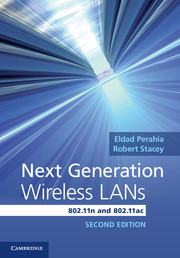Book contents
- Frontmatter
- Contents
- Foreword
- Preface to the first edition
- Preface to the second edition
- List of abbreviations
- Chapter 1 Introduction
- Part I Physical layer
- Chapter 2 Orthogonal frequency division multiplexing
- Chapter 3 MIMO/SDM basics
- Chapter 4 PHY interoperability with 11a/g legacy OFDM devices
- Chapter 5 High throughput
- Chapter 6 Robust performance
- Chapter 7 Very High Throughput PHY
- Part II Medium access control layer
- Part III Transmit beamforming, multi-user MIMO, and fast link adaptation
- Index
- References
Chapter 6 - Robust performance
from Part I - Physical layer
Published online by Cambridge University Press: 05 June 2013
- Frontmatter
- Contents
- Foreword
- Preface to the first edition
- Preface to the second edition
- List of abbreviations
- Chapter 1 Introduction
- Part I Physical layer
- Chapter 2 Orthogonal frequency division multiplexing
- Chapter 3 MIMO/SDM basics
- Chapter 4 PHY interoperability with 11a/g legacy OFDM devices
- Chapter 5 High throughput
- Chapter 6 Robust performance
- Chapter 7 Very High Throughput PHY
- Part II Medium access control layer
- Part III Transmit beamforming, multi-user MIMO, and fast link adaptation
- Index
- References
Summary
With the addition of MIMO to IEEE 802.11, many new WLAN devices will have multiple antennas. Though an important benefit of multiple antennas is increased data rate with multiple spatial streams, multiple antennas may be also used to significantly improve the robustness of the system. Multiple antennas enable optional features such as receive diversity, spatial expansion, transmit beamforming, and space-time block coding (STBC). The topic of transmit beamforming is addressed in Chapter 13.
Advanced coding has also been added to 802.11n to further improve link robustness with the inclusion of the optional low density parity check (LDPC) codes and STBC. STBC combines multiple antennas with coding.
To simplify notation in the following sections, the system descriptions for receive diversity, STBC, and spatial expansion are given in the frequency domain for a single subcarrier. This is done since each technique is in fact applied to each subcarrier in the frequency band. It is assumed that, at the transmitter, the frequency domain data is transformed into a time domain waveform as described in Section 4.2. Furthermore, the receive procedure to generate frequency domain samples is described in Section 4.2.4.
To quantify the benefits of these features, this chapter contains simulation results modeling each technique. For each function, the simulation results include physical layer impairments, as described in Section 3.5. The equalizer is based on MMSE. Synchronization, channel estimation, and phase tracking are included in the simulation. For receive diversity, spatial expansion, and STBC, the simulations are performed using channel model B with NLOS conditions, as described in Section 3.5. For LDPC, the simulation is performed using channel model D with NLOS conditions.
- Type
- Chapter
- Information
- Next Generation Wireless LANs802.11n and 802.11ac, pp. 147 - 181Publisher: Cambridge University PressPrint publication year: 2013



